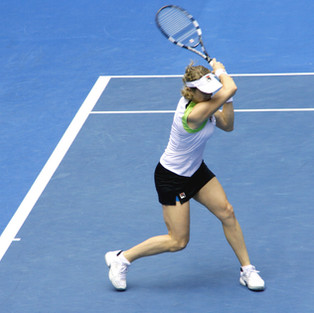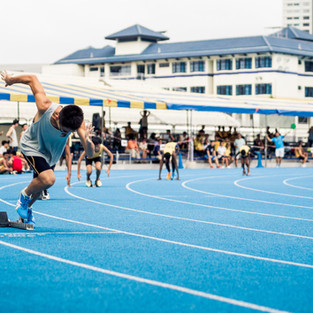THE ROLE OF A STRENGTH AND CONDITIONING COACH
- Canterbury Strength
- Nov 18, 2018
- 8 min read
Updated: Nov 30, 2021

The Strength and Conditioning Coach must identify and evaluate the physiological needs relating to either a whole sports team, an individual playing in a specific position as part of that team or an individual athlete. Once gaps between actual and ideal physical outcomes have been highlighted, the S&C practitioner is then responsible for designing and implementing periodised sports-specific programmes that will improve the athlete’s performance within that sport and reduce the occurrence of injury.
An S&C Coach can potentially work with a very diverse range of athletes, as great as the number of sports that exist! Physical demands put on an athlete are often very different depending on the sport, position or role that athlete is playing and so no athlete will be trained in exactly the same way. Track and field, gymnastics, and martial arts athletes must be coached differently as they all use different movement patterns recruiting different muscles, train at distinct intensities and experience different forces on the body. Professional Tennis players must carry out repetitive short, high-intensity sprints that will end in a movement that requires great explosive strength. Rowers will train for strength, speed and a greater aerobic and anaerobic capacity. Shot-putters are more successful if they have enhanced muscular hypertrophy because the greater cross-sectional area allows them to produce more force and power. NFL athletes must excel at strength, power, endurance, speed and a great range of other physical components to become accomplished at their sport. As a consequence each sport has it’s own risk of particular injuries associated with these demands.
The S&C Coach must communicate with other professionals as part of ongoing athlete monitoring. Ideally this involves an interdisciplinary approach, each professional exchanging up-to-date information with each other, rather than an athlete centered / multidisciplinary approach that can often lead to professionals contradicting each other and confusing the athlete. It is possible that the athlete has a very large number of support staff that are all working towards optimising the performance of that athlete. Head Coach, Technical Coaches, Nutritionist, Physiotherapists, Medical team, Sports Psychologists and sometimes even the athlete’s parents must work together to get the best out of a player. The extent to at which an S&C practitioner takes on other roles will depend on the support provided to the athlete by other professionals. However, as is necessary in all educating roles, it is crucial that a positive working relationship with the client is established quickly as the athlete will need to trust in the training decisions (research-based) made by the S&C Coach for the programme to be delivered effectively.
Analysis of performance demands
Biomechanics is the study of mechanical laws acting on a living organism. When looking

specifically at sport we are talking about the physics involved in movement such as ground reaction forces, velocities, movement patterns, strength-to-mass ratios and joint angle generated muscle contractions. How does any of this affect sports performance? The easiest way to understand this is to look at a case example such as place kicking in Rugby. To be successful the kicker must be able to both move the ball at high velocity and also aim with great accuracy. Foot linear velocity, knee extension velocity and hip extension velocity have been found to be greater when kicking for maximum velocity. Ankle dorsiflexion and peak external rotation were found to increase kicking accuracy. These high velocity movement patterns need to be replicated and improved during training. Exercises that involve triple extension for example Olympic Weightlifting movements such as cleans will increase power output during hip and knee extension and could be used as part of a periodised programme for a Rugby kicker. Plyometric exercises such as hurdle jumping, drop jumps and horizontal jumps have also shown to improve kicking distance and are effective if implemented into a training schedule for a minimum of 12 weeks. Accuracy will suffer if the Coach only tries to improve the biomechanics of kicking distance without any focus on improving the external rotation of the foot during the kick.
Physiological demands of training are to do with the fitness requirements of the athlete for optimal sports performance. When designing a programme for an athlete it is crucial to take into consideration both bioenergetic limiting factors that may reduce performance and the metabolic requirements of the sport. Bioenergetic limiting factors are the various energy stores and subsequent changes in hydrogen ions depending on the activity carried out. These include ATP & Creatine phosphate, muscle glycogen, liver glycogen, fat stores and blood pH. These factors are directly linked to the energy systems being used during the sport which in turn is dependent on the duration and intensity of the activity. The table below illustrates how duration and intensity affects the energy system that is required for an activity.
Duration Intensity Energy system
0-6 s Extremely high Phosphagen
6-30 s Very high Phosphagen & Glycolysis
30 s – 2 min High Glycolysis
2-3 min Moderate Glycolysis & Oxidative
>3 min Low Oxidative
Each athlete will require very specific training to optimise the system most utilised in their sport or position. For example, a Rugby full back must be good at short distance sprints that last less than 30 seconds, most only covering a distance of 10m. Short distance sprints will place a high demand on the athlete’s phosphagen and glycolytic system. If the player cannot work well at this duration they will be unable to achieve many of the tasks required by that position such as reaching an opponent on time to carry out a tackle or meeting a high kick before the opposition. Combined sled towing and sprint training (SLED) has been shown to be effective for improving short distance sprints of 10m and 30m. Repeated incline sprints of 15m, 20m and 25m in sets of 5 with a work rest ratio of 1 : 20 may help improve acceleration mechanics as well as hitting the most active energy pathways. These would be effective methods for training this athlete as opposed to asking them to carry out steady pace 5km runs during each training session which would only use the oxidative system.
Injury epidemiology refers to the analysis of injury within a sport by identifying common sites of joint or muscle injury and the causative factors. Injury location and frequency will vary dependant on the sport due to the specific movements patterns involved. Certain injuries such as lower body sprains or tendon tears are more frequent in sports that require rapid changes of direction, jumping and landing for example Basketball. The most common injuries in in this sport are specifically ankle sprains and knee injuries due to either rapid changes of direction or colliding with an opponent. It has been shown that proprioception exercises, balance training and strengthening exercises work well to reduce the rate of ankle injuries. Improving proprioception (the mind being able to sense where the body part is in space) can be achieved by carrying out single leg movements such as a squat on a wobble board. These can then be progressed to performing functional sport activities while in single-leg stance on the board. Mobility exercises can be used to improve the range of movement around the joint, the better the range the less risk of injury. They can be included at the beginning of resistance training sessions to prepare for movements under load. A particularly good
exercise is to stand facing a wall with hands leaning against the surface, stretch one leg behind, with knee straight, and foot flat on the floor. Lean the body forwards until a stretch is felt in the calf muscle. Hold for 30 seconds and repeat three times.
Assessment of an athlete’s capabilities

Health and Lifestyle screening
Questionnaires and diaries are inexpensive and convenient ways of monitoring an athlete’s lifestyle and health. This form of screening can reveal psychological and physiological variables that may affect performance, including sleep routine, quantity and quality, motivation, stress and anxiety, and also nutrition.
Posture and movement screening
The overhead squat is a common movement test for picking up problems in areas such as ankle dorsiflexion, hip mobility, thoracic mobility and glenohumeral mobility. During this test the participator must perform a deep squat holding a dowel above the head with fully extended arms. It is then possible to identify dysfunction by spotting any deviation from the technical model.
Physiological fitness and performance tests 1 RM Clean and 1 RM Snatch can be an effective way of testing for maximal muscular

power. The advantage of this type of field test is that it can be easier to administer, time effective and fairly inexpensive (providing there is access to a weightlifting gym). However, an athlete’s technique might be quite difficult to judge by eye as there is variation amongst individual lifters. The result of one lift could well be voided by another observer and therefore reduces the reliability of the results. These test are also very much limited by their parameters, maximal power can only be measured for the movements demanded to carry out the lift, the result may not be valid for muscular power involved in movement patterns that do not exactly replicate those carried out during the lift.
The Yo-Yo Intermittent Recovery test is often used to evaluate an athlete’s aerobic capacity by their ability to repeatedly perform intervals over a prolonged period of time. These multiple short distance running / sprint scenarios are common in field sports such as rugby and football. Cones are used to mark out a 20m and 5m section. Participants are required to run 20m and back as instructed by an audio recorded bleep, then follows a 10 seconds active recovery period where the participant can walk to the 5m cone and back before the next interval. The test is very easy to set up, requires minimal equipment and because it isn’t expensive, it can be used by the vast majority of sports teams regardless of their budget. Unfortunately this test is limited by the parameters that can be measured and may not accurately replicate real life game conditions. In many sports an athlete will frequently be required to sprint greater or shorter distances than 20m. Therefore, it may be better to adapt the test based on the typical conditions experienced by the sport or field position.

The Skinfold thickness measurement field test is a very convenient tool that Coaches can use to analyse a client’s body composition as it can be carried out pretty much anywhere and relatively quickly. The most common sites assessed include triceps, subscapular, suprailiac, abdomen, thigh and bicep. The skinfold measures are taken two or three times at each site and then averaged, these values are then put into an equation specific to the number of locations measured to then determine body fat percentage. Skinfold analysis has it’s limitations as it can only be used to measure subcutaneous fat under the skin and not visceral fat found around the organs. This method has been found to be considerably less accurate than laboratory-based tests such as Dual X-ray absorptiometry (DEXA) and hydrostatic weighing.
The information produced in this article has been collected from evidence based resources. These include research published by Sports Science journals, Strength and Conditioning course book material and textbooks produced in for the study of this field. No sources were used which appeared to have a conflict of interest (for example marketing or research bias) or which were not sufficiently referenced.
References
British Military Fitness Limited (2015) Level 4 Award in Strength and Conditioning
Haff G. Gregory, Triplett N. Travis (2016) Essentials of Strength Training, National Strength and Conditioning Association
http://www.humankinetics.com/excerpts/excerpts/strength-and-conditioning-coach
https://www.ncbi.nlm.nih.gov/pubmed/1428065
https://www.nsca.com/education/articles/3_field_methods_for_assessing_body_composition/
http://www.humankinetics.com/excerpts/excerpts/apply-biomechanics-to-improve-techniques
http://web.a.ebscohost.com/ehost/detail/detail?vid=0&sid=1bd83d76-3cb7-490e-8082-fe44ca0d4c5f%40sessionmgr4009&bdata=JnNpdGU9ZWhvc3QtbGl2ZQ%3d%3d#AN=123618980&db=s3h
https://www.ncbi.nlm.nih.gov/pubmed/19966586
https://www.ncbi.nlm.nih.gov/pubmed/22692118
http://www.irbsandc.com/?module=5§ion=24&subsection=60
https://www.acefitness.org/ptresources/pdfs/TestingProtocols/300YardShuttleRun.pdf
https://www.ncbi.nlm.nih.gov/pmc/articles/PMC3786241/
https://www.acefitness.org/continuingeducation/courses/support_items/OLC-PSM-ASI/AnkleSprainAugust2014.pdf
http://www.innspub.net/wp-content/uploads/2014/06/IJB-V4N08-p269-276.pdf
http://www.uhs.nhs.uk/Media/Controlleddocuments/Patientinformation/Medicinestherapiesandanaesthetics/Anklemobilisingexercisespatientinformation.pdf
http://www.humankinetics.com/excerpts/excerpts/physical-demands-of-tennis

.jpg)



















The Lenovo X1 Carbon boots fast and runs all our standard business apps smoothly.
At Alberta Tree Planting , we specialize in providing professional tree planting services in Calgary and across Alberta, ensuring your landscape thrives with the right trees for your property. Whether you're looking to buy trees in Calgary , require tree transplanting services , or need expert sod removal services in Alberta , we have the expertise to meet your needs. We offer a variety of trees and shrubs for sale, perfect for Alberta's growing zones and climate. From providing guidance on the best time to plant trees in Alberta , to delivering large caliper tree planting and efficient skid steer services in Calgary , our team is ready to assist you. Looking for tree planting jobs in Alberta ? Join our team of professional tree planters. We pride ourselves on…
Discover cutting-edge AI agents in Australia with ToothFairy AI. Our advanced virtual assistants streamline customer interactions, automate tasks, and enhance business efficiency. From AI-powered chatbots to intelligent automation, we provide innovative solutions for seamless user experiences. Explore how our AI technology can transform your business today! Visit ToothFairy AI .
I enjoyed reading this! This covers some important aspects that often get overlooked. Thanks for shedding light on them in such a clear and concise manner. bursa almanca yeminli tercüman
gebze yeminli tercüman
yeminli tercüman gebze
kartal yeminli tercüman
levent yeminli tercüman
ümraniye yeminli tercüman
eskişehir yeminli tercüman
mersin yeminli tercüman
iskenderun yeminli tercüman
Translation Agency in Dubai
Find out how to budget like a pro with practical strategies for saving, spending, and planning wisely. Master your money with our expert advice on how to budget for short-term and long-term success.